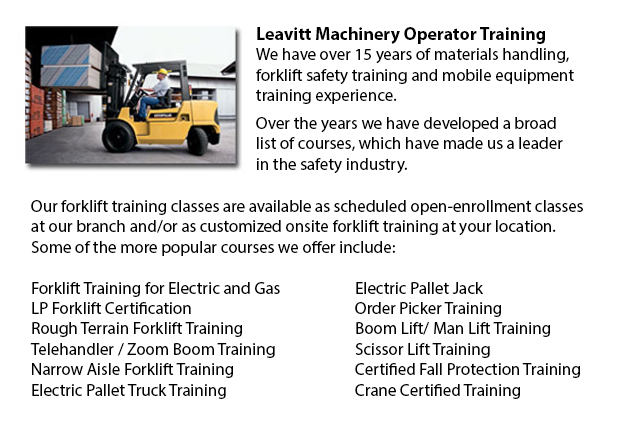
Forklift Training Schools Toronto - Forklift Training Schools
Are you looking for a job as a driver of a forklift? Our regulatory-compliant mobile equipment operator training offers instruction in types of lift trucks, pre-shift inspection, fuel kinds and dealing with fuels, and safe utilization of a lift truck. Practical, hands-on training assists participants in acquiring essential operational skills. Course content consists of existing regulations governing the operation of forklifts. Our proven forklift courses are intended to offer training on these kinds of trucks: counterbalanced forklift, powered pallet trucks and narrow isle forklift.
Do not raise or lower the fork while the lift truck is moving. A load should not extend higher than the backrest because of the risk of the load sliding back in the direction of the operator. Inspect for overhead obstacles and make certain there is enough clearance prior to lifting a load. Stay away from overhead power lines. When the load is raised straight up, tilt it slightly back.
The lift truck is less steady if a load is in a raised position. Make certain that no one ever walks beneath the elevated fork. The operator should not leave the forklift when the load is lifted.
While handling pallets, forks must be level and high enough to go into the pallet and extend all the way below the load. The width of the forks must provide equal weight distribution.
Chock the wheels and set the brakes before loading and unloading the truck. The floors must be strong enough to support the weight of both the load and the forklift. Fixed jacks can be installed in order to support a semi-trailer which is not coupled to a tractor. The entrance door height should clear the forklift height by at least 5 cm. Edges of docks, rail cars and ramps should be marked and avoid them.
-
Aerial Platform Training Toronto
Aerial Platform Training Toronto - Aerial forklifts can accommodate numerous duties involving high and tough reaching places. Normally used to carry out daily preservation in structures with elevated ceilings, prune tree branches, raise heavy shelvin... More -
Overhead Crane Operator Training Toronto
Overhead Crane Operator Training Toronto - Our overhead crane operator training course is designed to teach workers the fundamentals of overhead crane/sling operation and pre-shift inspections. Programs are taught by our professional trainers and con... More -
Warehouse Forklift Training Programs Toronto
Warehouse Forklift Training Programs Toronto - Warehouses can either be industrial, commercial or retail facilities, functioning from product distribution services to bulk product retailing. Regardless of the type of warehouse, staff inside warehouse... More -
Forklift Ticket Toronto
Forklift Ticket Toronto - Pallet jacks and forklifts are both used for basically the same purpose; to move goods from a place of your warehouse to another. This is basically where the comparison stops though. With the pallet jack, the benefits are ex... More -
Scissor Lift Ticket Toronto
Scissor Lift Ticket Toronto - The scissor forklift has been a great advantage to a lot of companies since the effort and manpower to run one of these machines is extremely minimum. Additionally, many workplace injuries have been prevented by having o... More -
Aerial Lift Ticket Toronto
Aerial Lift Ticket Toronto - A boom truck is sometimes recognized by the cable and phone company vehicles that have the elongated arm folded over their roofs. Commonly, a bucket-like equipment sits at the extension of extendable arms. Normally called... More -
Aerial Boom Lift Training Toronto
Aerial Boom Lift Training Toronto - Aerial Boom Lift Training is required for any person who operates, supervises or works near boom lifts. This type of aerial lift or aerial work platform is for lifting individuals, materials and tools in projects r... More -
Aerial Lift Certification Toronto
Aerial Lift Certification Toronto - Aerial Lift Certification is for personnel who require a thorough knowledge of aerial lift safety. Supervisors, maintenance workers and construction craftsmen require this training to make sure that inspectors and... More

Forklift Training Toronto
TOLL FREE: 1-888-254-6157
Toronto, Ontario
forklifttrainingtorontoontario.ca
Email Us
About Us


